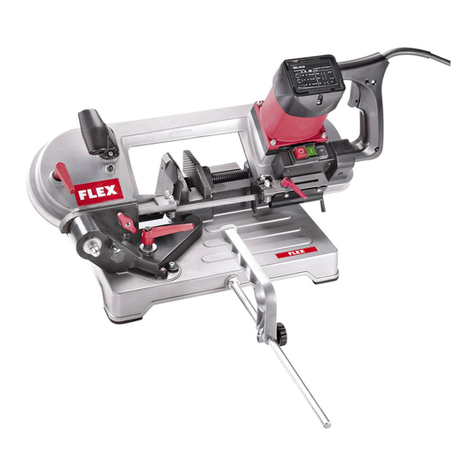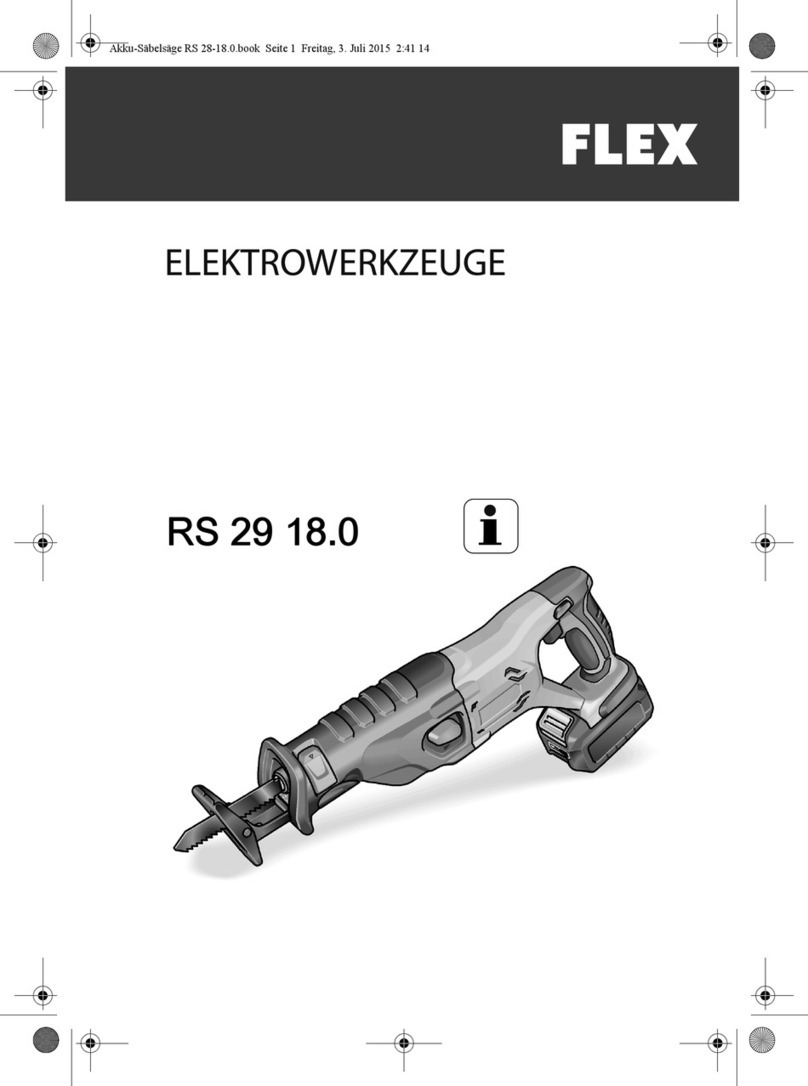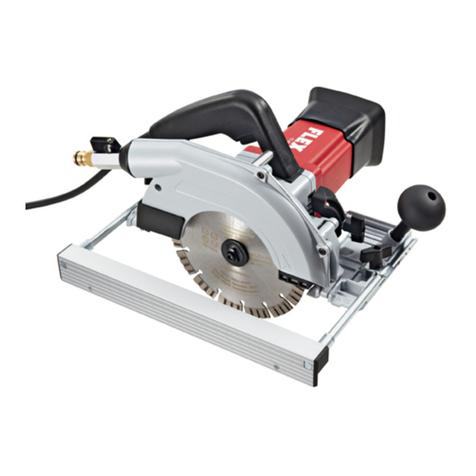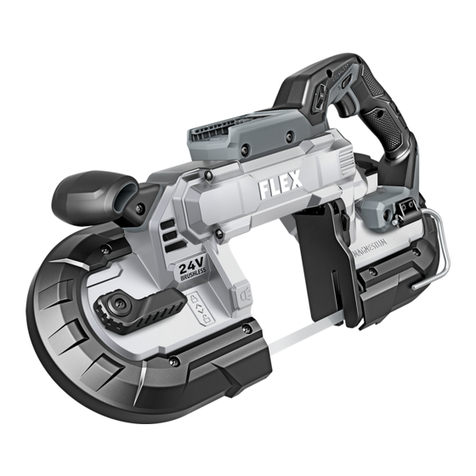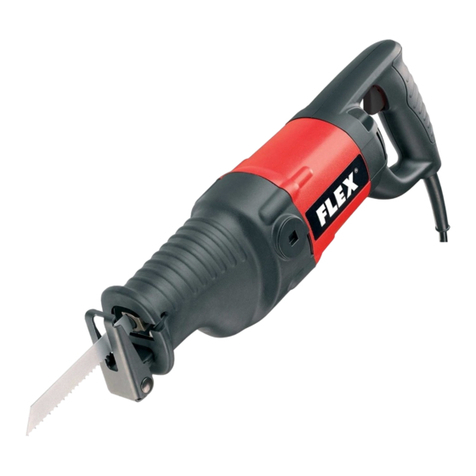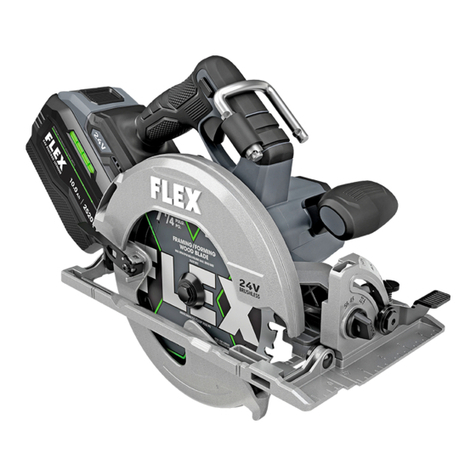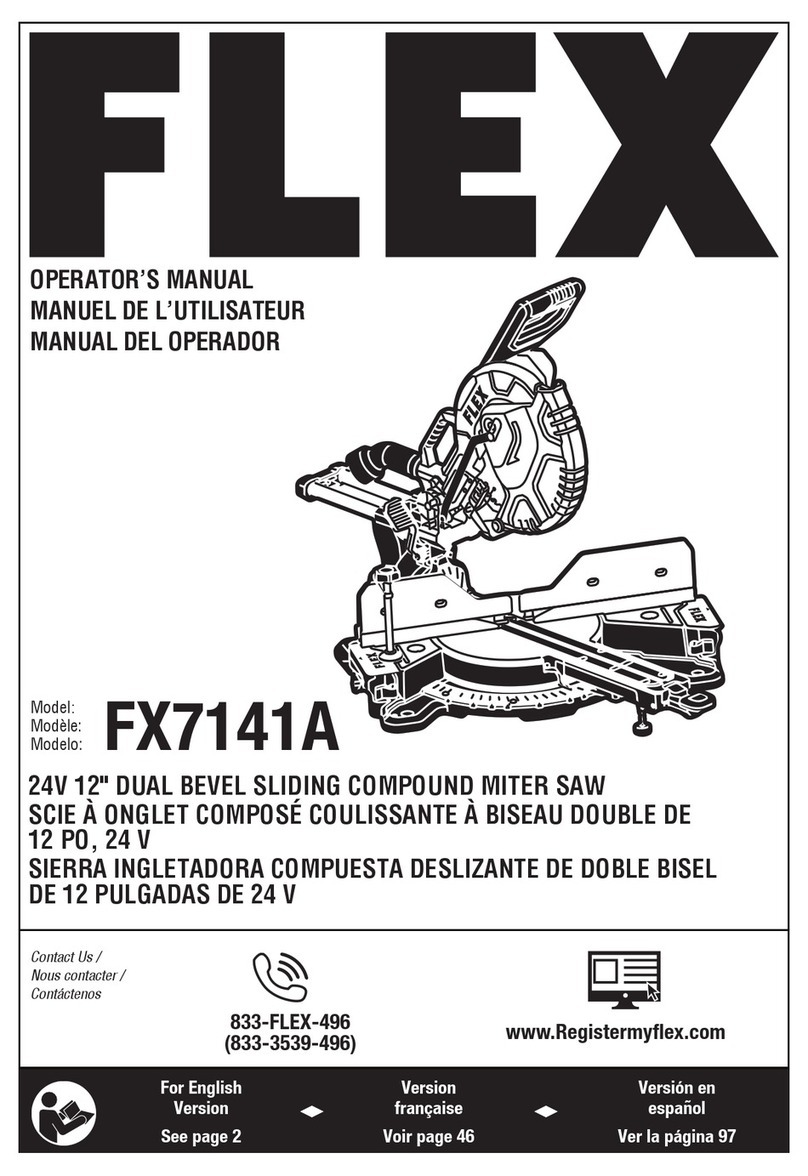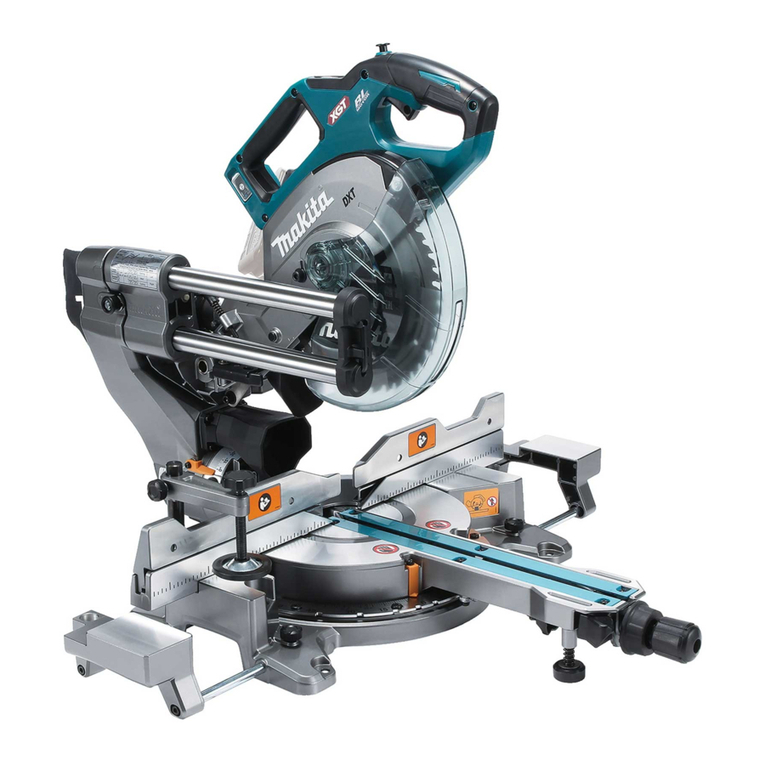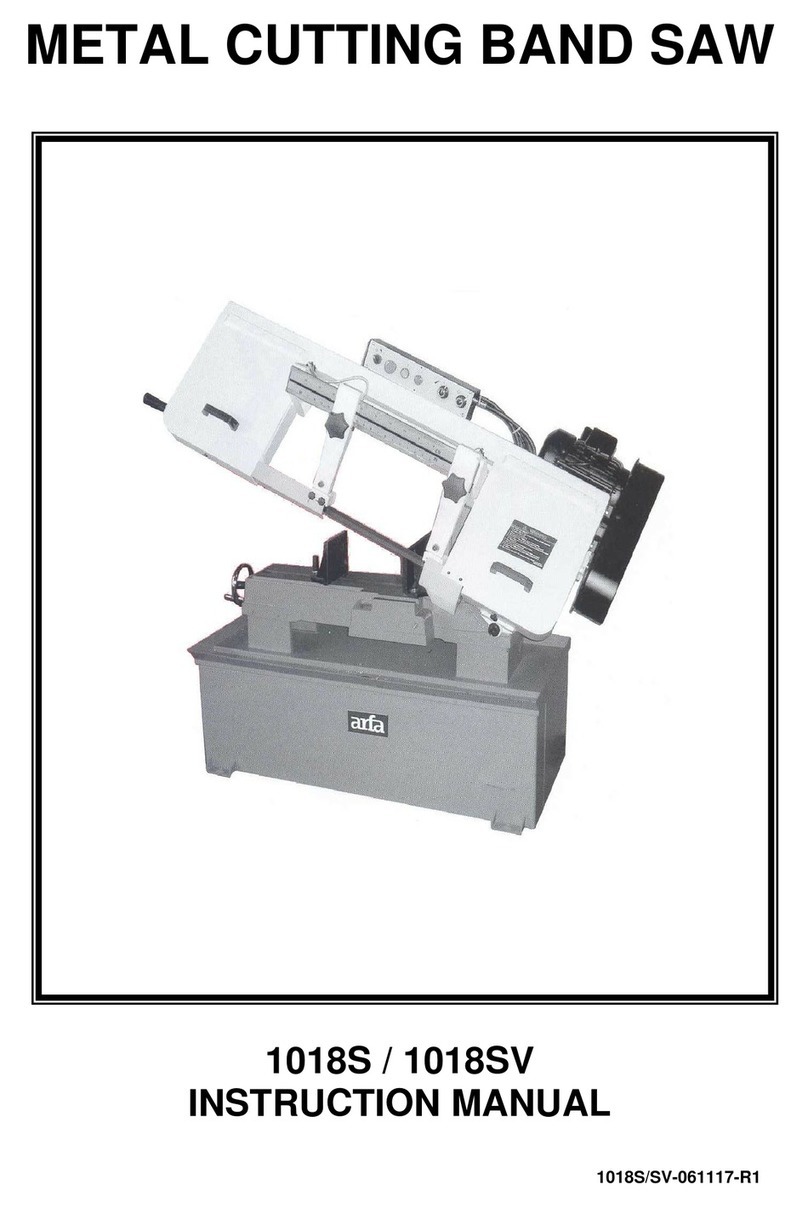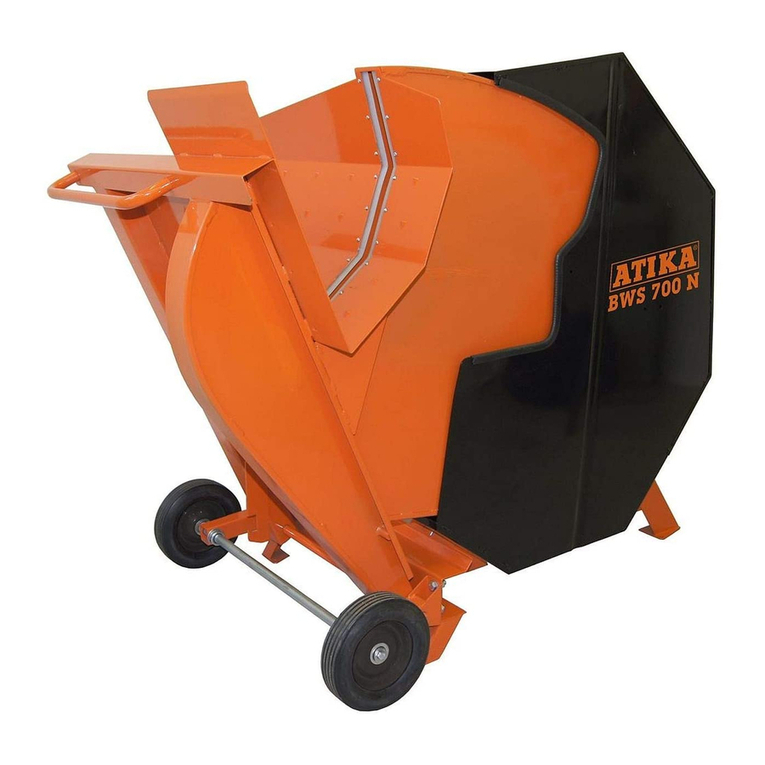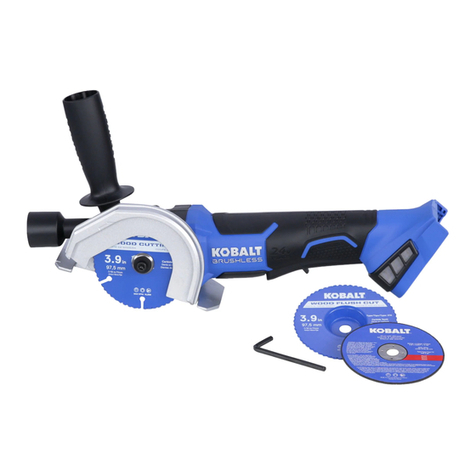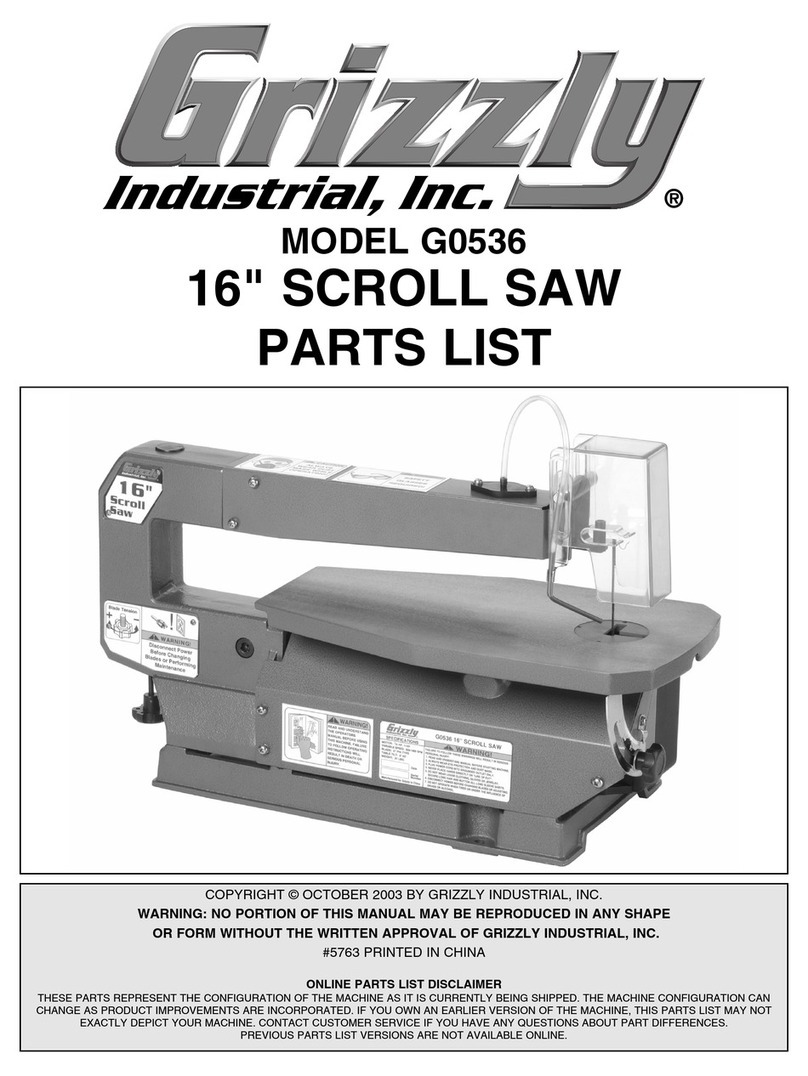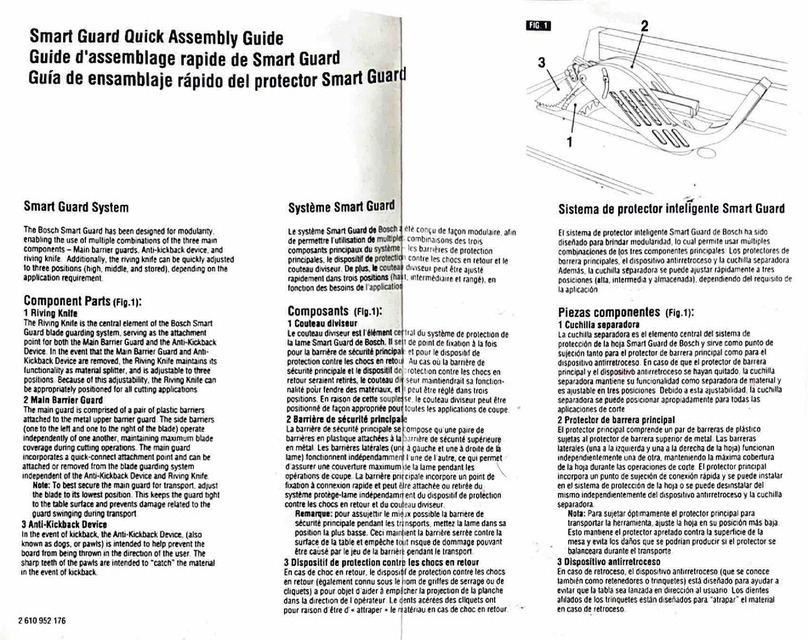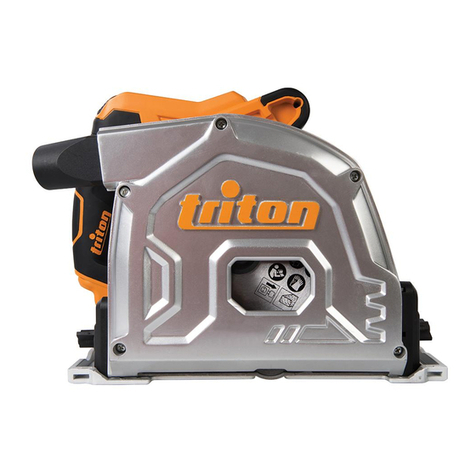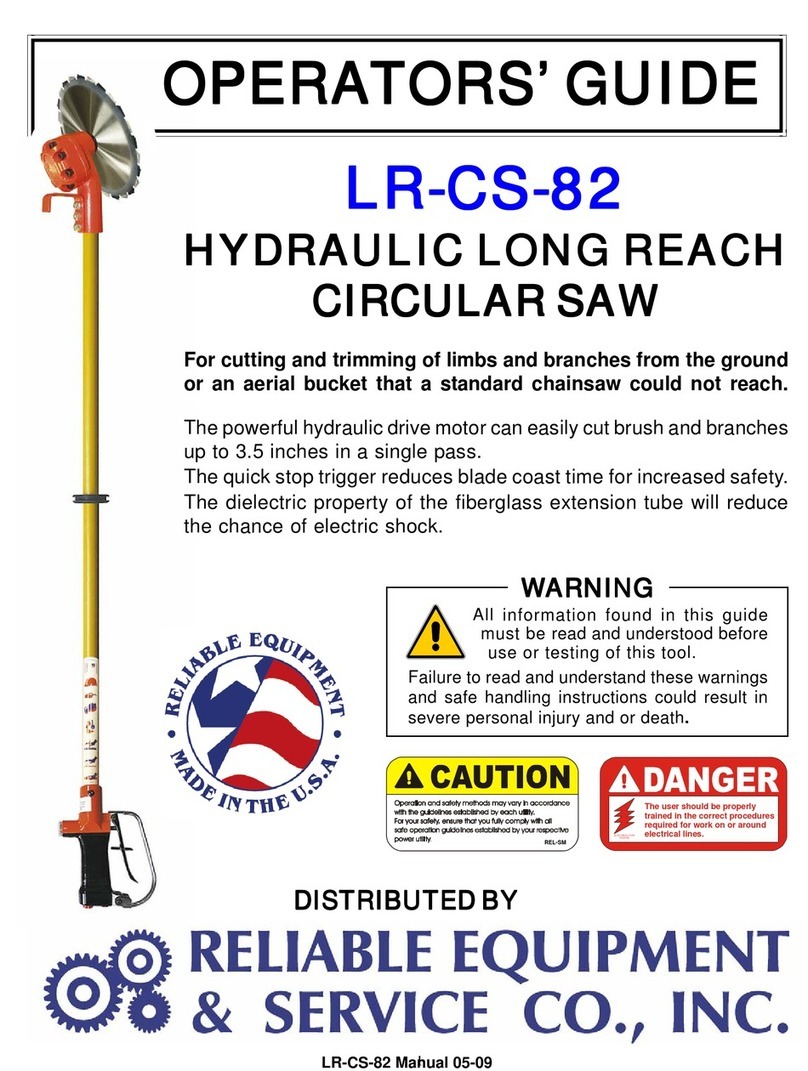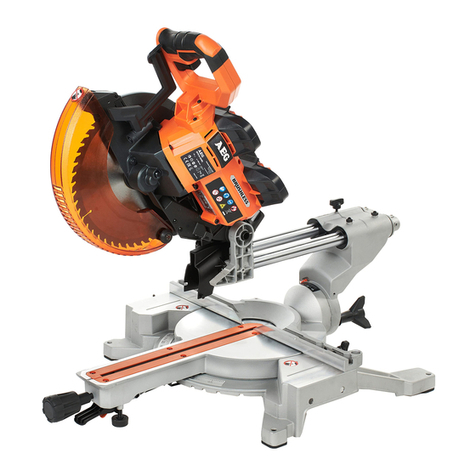Flex FX7211 User manual

Model:
Modèle:
Modelo:
OPERATOR’S MANUAL
MANUEL DE L’UTILISATEUR
MANUAL DEL OPERADOR
833-FLEX-496
(833-3539-496)
For English
Version
See page 2
◆
Version
française
Voir page 56
◆
Versión en
español
Ver la página 115
www.Registermyex.com
Contact Us /
Nous contacter /
Contáctenos
24V 8-1/4 IN. TABLE SAW
SCIE À TABLE DE 24 V, 8-1/4 PO
SIERRA DE MESA DE 8-1/4 PULGADAS DE 24 V
FX7211

-2-
SAFETY SYMBOLS
The purpose of safety symbols is to attract your attention to possible dangers. The safety symbols
and the explanations with them deserve your careful attention and understanding. The symbol
warnings do not, by themselves, eliminate any danger. The instructions and warnings they give are
no substitutes for proper accident prevention measures.
WARNING Be sure to read and understand all safety instructions in this Operator’s Manual,
including all safety alert symbols such as “DANGER,” “WARNING,” and
“CAUTION” before using this tool. Failure to follow all instructions listed below may result in electric
shock, re, and/or serious personal injury.
The denitions below describe the level of severity for each signal word. Please read the manual and
pay attention to these symbols.
This is the safety alert symbol. It is used to alert you to potential personal
injury hazards. Obey all safety messages that follow this symbol to avoid
possible injury or death.
DANGER DANGER indicates a hazardous situation which, if not avoided, will result in
death or serious injury.
WARNING WARNING indicates a hazardous situation which, if not avoided, could result
in death or serious injury.
CAUTION CAUTION, used with the safety alert symbol, indicates a hazardous situation
which, if not avoided, will result in minor or moderate injury.
Damage Prevention and Information Messages
These inform the user of important information and/or instructions that could lead to equipment or
other property damage if they are not followed. Each message is preceded by the word “NOTICE”,
as in the example below:
NOTICE Equipment and/or property damage may result if these instructions are not followed.
WARNING The operation of any power tools can result in foreign
objects being thrown into your eyes, which can result in
severe eye damage. Before beginning power tool operation, always wear
safety goggles or safety glasses with side shields and a full face shield when
needed. We recommend a Wide Vision Safety Mask for use over eyeglasses
or standard safety glasses with side shields. Always use eye protection which
is marked to comply with ANSI Z87.1.

-3-
GENERAL POWER TOOL SAFETY WARNINGS
WARNING Read all safety warnings, instructions, illustrations and specications
provided with this power tool. Failure to follow all instructions listed below may
result in electric shock, re and/or serious injury.
SAVE ALL WARNINGS AND INSTRUCTIONS FOR FUTURE REFERENCE.
The term “power tool” in the warnings refers to your mains-operated (corded) power tool or battery-
operated (cordless) power tool.
Work area safety
Keep work area clean and well lit. Cluttered
or dark areas invite accidents.
Do not operate power tools in explosive
atmospheres, such as in the presence of
ammable liquids, gases or dust. Power
tools create sparks which may ignite the dust or
fumes.
Keep children and bystanders away while
operating a power tool. Distractions can cause
you to lose control.
Electrical safety
Power tool plugs must match the outlet.
Never modify the plug in any way. Do
not use any adapter plugs with earthed
(grounded) power tools. Unmodied plugs
and matching outlets will reduce risk of electric
shock.
Avoid body contact with earthed or
grounded surfaces, such as pipes, radiators,
ranges and refrigerators. There is an
increased risk of electric shock if your body is
earthed or grounded.
Do not expose power tools to rain or wet
conditions. Water entering a power tool will
increase the risk of electric shock.
Do not abuse the cord. Never use the cord
for carrying, pulling or unplugging the
power tool. Keep cord away from heat, oil,
sharp edges or moving parts. Damaged or
entangled cords increase the risk of electric
shock.
When operating a power tool outdoors, use
an extension cord suitable for outdoor use.
Use of a cord suitable for outdoor use reduces
the risk of electric shock.
If operating a power tool in a damp location
is unavoidable, use a ground fault circuit
interrupter (GFCI) protected supply. Use of a
GFCI reduces the risk of electric shock.
Personal safety
Stay alert, watch what you are doing and
use common sense when operating a power
tool. Do not use a power tool while you are
tired or under the inuence of drugs, alcohol
or medication. A moment of inattention while
operating power tools may result in serious
personal injury.
Use personal protective equipment. Always
wear eye protection. Protective equipment
such as a dust mask, non-skid safety shoes,
hard hat or hearing protection used for
appropriate conditions will reduce personal
injuries.
Prevent unintentional starting. Ensure
the switch is in the off-position before
connecting to power source and/or battery
pack, picking up or carrying the tool.
Carrying power tools with your nger on the
switch or energizing power tools that have the
switch on invites accidents.
Remove any adjusting key or wrench before
turning the power tool on. A wrench or a key
left attached to a rotating part of the power tool
may result in personal injury.
Do not overreach. Keep proper footing and
balance at all times. This enables better control
of the power tool in unexpected situations.
Dress properly. Do not wear loose clothing
or jewelry. Keep your hair, and clothing away
from moving parts. Loose clothes, jewelry or
long hair can be caught in moving parts.
If devices are provided for the connection
of dust extraction and collection facilities,
ensure these are connected and properly
used. Use of dust collection can reduce dust-
related hazards.
Do not let familiarity gained from frequent
use of tools allow you to become
complacent and ignore tool safety
principles. A careless action can cause severe
injury within a fraction of a second.

-4-
Power tool use and care
Do not force the power tool. Use the correct
power tool for your application. The correct
power tool will do the job better and safer at the
rate for which it was designed.
Do not use the power tool if the switch
does not turn it on and off. Any power tool
that cannot be controlled with the switch is
dangerous and must be repaired.
Disconnect the plug from the power
source and/or remove the battery pack,
if detachable, from the power tool before
making any adjustments, changing
accessories, or storing power tools. Such
preventive safety measures reduce the risk of
starting the power tool accidentally.
Store idle power tools out of the reach of
children and do not allow persons unfamiliar
with the power tool or these instructions
to operate the power tool. Power tools are
dangerous in the hands of untrained users.
Maintain power tools and accessories.
Check for misalignment or binding of
moving parts, breakage of parts and any
other condition that may affect the power
tool’s operation. If damaged, have the power
tool repaired before use. Many accidents are
caused by poorly maintained power tools.
Keep cutting tools sharp and clean. Properly
maintained cutting tools with sharp cutting
edges are less likely to bind and are easier to
control.
Use the power tool, accessories and
tool bits etc. in accordance with these
instructions, taking into account the working
conditions and the work to be performed.
Use of the power tool for operations different
from those intended could result in a hazardous
situation.
Keep handles and grasping surfaces dry,
clean and free from oil and grease. Slippery
handles and grasping surfaces do not allow
for safe handling and control of the tool in
unexpected situations.
Battery tool use and care
Recharge only with the charger specied by
the manufacturer. A charger that is suitable for
one type of battery pack may create a risk of re
when used with another battery pack.
Use power tools only with specically
designated battery packs. Use of any other
battery packs may create a risk of injury and
re.
When battery pack is not in use, keep it
away from other metal objects, like paper
clips, coins, keys, nails, screws or other
small metal objects, that can make a
connection from one terminal to another.
Shorting the battery terminals together may
cause burns or a re.
Under abusive conditions, liquid may be
ejected from the battery; avoid contact.
If contact accidentally occurs, ush with
water. If liquid contacts eyes, additionally
seek medical help. Liquid ejected from the
battery may cause irritation or burns.
Do not use a battery pack or tool that is
damaged or modied. Damaged or modied
batteries may exhibit unpredictable behavior
resulting in re, explosion or risk of injury.
Do not expose a battery pack or tool to re
or excessive temperature. Exposure to re or
temperature above 265 °F (130 °C) may cause
explosion.
Follow all charging instructions and do
not charge the battery pack or tool outside
the temperature range specied in the
instructions. Charging improperly or at
temperatures outside the specied range may
damage the battery and increase the risk of re.
Service
Have your power tool serviced by a
qualied repair person using only identical
replacement parts. This will ensure that the
safety of the power tool is maintained.
Never service damaged battery packs.
Service of battery packs should only be
performed by the manufacturer or authorized
service providers.

-5-
SAFETY INSTRUCTIONS FOR TABLE SAW
GUARDING RELATED WARNINGS
• Keep guards in place. Guards must be in
working order and be properly mounted.
A guard that is loose, damaged, or is not
functioning correctly must be repaired or
replaced.
• Always use saw blade guard, riving
knife and anti-kickback device for every
through-cutting operation. For through-
cutting operations where the saw blade
cuts completely through the thickness of the
workpiece, the guard and other safety devices
help reduce the risk of injury.
• After completing a non-through cut such
as rabbeting, resawing, or dadoing, restore
the riving knife to the extended-up position.
With the riving knife in the extended-up
position, reattach the blade guard and
the anti-kickback device. The guard, riving
knife, and anti-kickback device help to reduce
the risk of injury.
• Make sure the saw blade is not contacting
the guard, riving knife or the workpiece
before the switch is turned on. Inadvertent
contact of these items with the saw blade
could cause a hazardous condition.
• Adjust the riving knife as described in
this instruction manual. Incorrect spacing,
positioning and alignment can make the riving
knife ineffective in reducing the likelihood of
kickback.
• For the riving knife and anti-kickback
device to work, they must be engaged in
the workpiece. The riving knife and anti-
kickback device are ineffective when cutting
workpieces that are too short to be engaged
with the riving knife and anti-kickback device.
Under these conditions a kickback cannot be
prevented by the riving knife and anti-kickback
device.
• Use the appropriate saw blade for the
riving knife. For the riving knife to function
properly, the saw blade diameter must match
the appropriate riving knife and the body of the
saw blade must be thinner than the thickness
of the riving knife and the cutting width of the
saw blade must be wider than the thickness of
the riving knife.
CUTTING PROCEDURES WARNINGS
WARNING Never place your ngers
or hands in the vicinity or
in line with the saw blade. A moment of
inattention or a slip could direct your hand
towards the saw blade and result in serious
personal injury.
• Feed the workpiece into the saw blade or
cutter only against the direction of rotation.
Feeding the workpiece in the same direction
that the saw blade is rotating above the table
may result in the workpiece, and your hand,
being pulled into the saw blade.
• Never use the miter gauge to feed the
workpiece when ripping and do not use
the rip fence as a length stop when cross
cutting with the miter gauge. Guiding
the workpiece with the rip fence and the
miter gauge at the same time increases the
likelihood of saw blade binding and kickback.
• When ripping, always keep the workpiece
in full contact with the fence and always
apply the workpiece feeding force between
the fence and the saw blade. Use a push
stick when the distance between the fence
and the saw blade is less than 150 mm
(6 in.), and use a push block when this
distance is less than 50 mm (2 in.). “Work
helping” devices will keep your hand at a safe
distance from the saw blade.
• Use only the push stick provided by the
manufacturer or constructed in accordance
with the instructions. This push stick
provides sufcient distance of the hand from
the saw blade.
• Never use a damaged or cut push stick. A
damaged or cut push stick may break causing
your hand to slip into the saw blade.
• Do not perform any operation “freehand”.
Always use either the rip fence or the miter
gauge to position and guide the workpiece.
“Freehand” means using your hands to
support or guide the workpiece, in lieu of a rip
fence or miter gauge. Freehand sawing leads
to misalignment, binding and kickback.
• Never reach around or over a rotating saw
blade. Reaching for a workpiece may lead to
accidental contact with the moving saw blade.

-6-
• Provide auxiliary workpiece support to the
rear and/or sides of the saw table for long
and/or wide workpieces to keep them level.
A long and/or wide workpiece has a tendency
to pivot on the table’s edge, causing loss of
control, saw blade binding and kickback.
• Feed the workpiece at an even pace. Do not
bend, twist or shift the workpiece from side
to side. If jamming occurs, turn the tool
off immediately, remove or disconnect the
battery pack, then clear the jam. Jamming
the saw blade by the workpiece can cause
kickback or stall the motor.
• Do not remove pieces of cut-off material
while the saw is running. The material may
become trapped between the fence or inside
the saw blade guard and the saw blade pulling
your ngers into the saw blade. Turn the saw
off and wait until the saw blade stops before
removing material.
• Use an auxiliary fence in contact with the
table top when ripping workpieces less
than 2 mm (0.08 in.) thick. A thin workpiece
may wedge under the rip fence and create a
kickback.
KICKBACK CAUSES AND RELATED
WARNINGS
Kickback is a sudden reaction of the workpiece
due to a pinched, jammed saw blade or
misaligned line of cut in the workpiece with
respect to the saw blade or when a part of the
workpiece binds between the saw blade and the
rip fence or other xed object.
Most frequently during kickback, the workpiece
is lifted from the table by the rear portion of
the saw blade and is propelled towards the
operator.
Kickback is the result of saw misuse and/or
incorrect operating procedures or conditions
and can be avoided by taking proper
precautions as given below.
• Never stand directly in line with the saw
blade. Always position your body on the
same side of the saw blade as the fence.
Kickback may propel the workpiece at high
velocity towards anyone standing in front and
in line with the saw blade.
• Never reach over or in back of the saw
blade to pull or to support the workpiece.
Accidental contact with the saw blade may
occur or kickback may drag your ngers into
the saw blade.
• Never hold and press the workpiece that
is being cut off against the rotating saw
blade. Pressing the workpiece being cut off
against the saw blade will create a binding
condition and kickback.
• Align the fence to be parallel with the
saw blade. A misaligned fence will pinch the
workpiece against the saw blade and create
kickback.
• Use a featherboard to guide the workpiece
against the table and fence when making
non-through cuts such as rabbeting,
dadoing or resawing cuts. A featherboard
helps to control the workpiece in the event of a
kickback.
• Use extra caution when making a cut into
blind areas of assembled workpieces. The
protruding saw blade may cut objects that can
cause kickback.
• Support large panels to minimize the risk
of saw blade pinching and kickback. Large
panels tend to sag under their own weight.
Support(s) must be placed under all portions
of the panel overhanging the table top.
• Use extra caution when cutting a workpiece
that is twisted, knotted, warped or does not
have a straight edge to guide it with a miter
gauge or along the fence. A warped, knotted,
or twisted workpiece is unstable and causes
misalignment of the kerf with the saw blade,
binding and kickback.
• Never cut more than one workpiece,
stacked vertically or horizontally. The saw
blade could pick up one or more pieces and
cause kickback.
• When restarting the saw with the saw
blade in the workpiece, center the saw
blade in the kerf so that the saw teeth are
not engaged in the material. If the saw blade
binds, it may lift up the workpiece and cause
kickback when the saw is restarted.
• Keep saw blades clean, sharp, and with
sufcient set. Never use warped saw
blades or saw blades with cracked or
broken teeth. Sharp and properly set saw
blades minimize binding, stalling and kickback.

-7-
TABLE SAW OPERATING PROCEDURE
WARNINGS
• Turn off the table saw and remove or
disconnect the battery pack when removing
the table insert, changing the saw blade
or making adjustments to the riving knife,
anti-kickback device or saw blade guard,
and when the machine is left unattended.
Precautionary measures will avoid accidents.
• Never leave the table saw running
unattended. Turn it off and don’t leave the
tool until it comes to a complete stop. An
unattended running saw is an uncontrolled
hazard.
• Locate the table saw in a well-lit and
level area where you can maintain good
footing and balance. It should be installed
in an area that provides enough room to
easily handle the size of your workpiece.
Cramped, dark areas, and uneven slippery
oors invite accidents.
• Frequently clean and remove sawdust
from under the saw table and/or the dust
collection device. Accumulated sawdust is
combustible and may self-ignite.
• The table saw must be secured. A table saw
that is not properly secured may move or tip
over.
• Remove tools, wood scraps, etc. from
the table before the table saw is turned
on. Distraction or a potential jam can be
dangerous.
• Always use saw blades with correct size
and shape (diamond versus round) of
arbor holes. Saw blades that do not match
the mounting hardware of the saw will run off-
center, causing loss of control.
• Never use damaged or incorrect saw
blade mounting means such as anges,
saw blade washers, bolts or nuts. These
mounting means were specially designed
for your saw for safe operation and optimum
performance.
• Never stand on the table saw; do not use
it as a stepping stool. Serious injury could
occur if the tool is tipped or if the cutting tool is
accidentally contacted.
• Make sure that the saw blade is installed
to rotate in the proper direction. Do not
use grinding wheels, wire brushes, or
abrasive wheels on a table saw. Improper
saw blade installation or use of accessories
not recommended may cause serious injury.
ADDITIONAL SAFETY RULES
MAKE WORKSHOP CHILD-PROOF with
padlocks, master switches.
Make sure the oor is clean and non-
slippery or non-skid where the table saw is
set up. If you cannot control your motion, you
cannot control the work.
Use only recommended accessories.
Use only accessories recommended by the
manufacturer of your model. Other accessories
may be hazardous.
Do not use any blade or other cutting tool
marked for an operating speed less than
6000/min (RPM) Risk of serious injury.
Ensure that blade or other cutting tool,
washers and arbor nut are installed properly.
Reference instructions for removal and
installation of the blade.
Never operate the saw unless the proper
insert is installed. Make sure the table insert
is ush or slightly below the table surface at the
front and ush to slightly above at the rear of
insert.
Always inspect table saw prior to every
use. If any part of your saw is missing,
malfunctioning, or has been damaged or broken
(such as the motor switch or other operating
control, a safety device, or the power cord),
cease operating immediately until the particular
part is properly repaired or replaced.
Plastic and composition (like hardboard)
materials may be cut on your saw. However,
since these are usually quite hard and
slippery, the anti-kickback pawls may not
stop a kickback. Therefore, be especially
attentive to following proper set-up and cutting
procedures for ripping. Do not stand, or permit
anyone else to stand, in line with a potential
kickback.

-8-
Use extra caution when the guard assembly
is removed for resawing, dadoing, rabbeting
or molding. Replace the guard as soon as that
operation is completed.
Use auxiliary facing on miter gauge to
increase stability and control. Crosscutting
operations are more conveniently worked and
with greater safety if an auxiliary wood facing
board is attached to the miter gauge. See “Rip
Fence Auxiliary Facing.”
Avoid awkward operations and hand
positions where a sudden slip could cause
ngers or hand to move into the sawblade or
other cutting tool.
If you stall or jam the sawblade in the
workpiece, turn saw OFF and disconnect the
battery pack, remove the workpiece from the
sawblade, and check to see if the sawblade
is parallel to the table slots or grooves and
if the riving knife is in proper alignment with
the sawblade. If ripping at the time, check to
see if the rip fence is parallel with the sawblade.
Readjust as indicated.
Think Safety. Safety is a combination of
operator common sense and alertness at all
times when the table saw is being used.
DANGER People with electronic
devices, such as
pacemakers, should consult their
physician(s) before using this product.
Operation of electrical equipment in close
proximity to a heart pacemaker could cause
interference or failure of the pacemaker.
WARNING
Drilling, sawing, sanding or machining wood
products can expose you to wood dust, a
substance known to the State of California to
cause cancer. Avoid inhaling wood dust or use
a dust mask or other safeguards for personal
protection. For more information go to
www.P65Warnings.ca.gov/wood
WARNING
Some dust created by power sanding, sawing,
grinding, drilling and other construction activities
contains chemicals known to the State of
California to cause cancer, birth defects or other
reproductive harm. Some examples of these
chemicals are:
– Lead from lead-based paints.
– Crystalline silica from bricks, cement, and
other masonry products.
– Arsenic and chromium from chemically-treated
lumber.
Your risk from these exposures varies,
depending upon how often you do this type
of work. To reduce your exposure to these
chemicals:
– Work in a well-ventilated area.
– Work with approved safety equipment, such as
dust masks that are specially designed to lter
out microscopic particles.
– Avoid prolonged contact with dust from power
sanding, sawing, grinding, drilling, and other
construction activities. Wear protective clothing
and wash exposed areas with soap and water.
Allowing dust to get into your mouth or eyes or
to lie on the skin may promote absorption of
harmful chemicals.

-9-
ELECTRICAL REQUIREMENTS
Electric brake
Your saw is equipped with an automatic electric
brake which is designed to stop the blade from
spinning in about four (4) seconds after you turn
the saw off. It is useful when making certain cuts
in wood where a coasting blade would result in
a wide, imprecise cut.
WARNING When the FLEX power
adapter is used, if the
electrical power is lost due to blown fuse or
other causes, the motor will gradually slow
down and the braking action is initiated
ONLY by the release of the trigger switch.
The electric blade brake of your table saw has
been designed for highest degree of reliability,
but unexpected circumstances such as
contamination on the commutator and brushes,
failure of motor’s components or overheating
can cause the brake not to activate. If this
condition occurs, turn the saw ON and OFF four
to ve times without contacting the workpiece.
If the tool operates but the brake does not
consistently stop the blade in about ve
seconds, DO NOT use saw and have it serviced
immediately.
WARNING The brake action of this
saw is not intended as a
safety feature. Remember to let the saw
blade come to a complete stop before
removing the workpiece or cut-off pieces. As
always, the guard system is your best
protection against unintentional contact with
a spinning saw blade. NEVER wedge open or
defeat the closing action of the guard.

-10-
SYMBOLS
IMPORTANT: Some of the following symbols may be used on your tool. Please study them and
learn their meaning. Proper interpretation of these symbols will allow you to operate the tool better
and safer.
Symbol Name Designation/Explanation
V Volts Voltage
A Amperes Current
Hz Hertz Frequency (cycles per second)
W Watt Power
kg Kilograms Weight
min Minutes Time
s Seconds Time
Wh Watt-hours Battery capacity
Ah Ampere-hours Battery capacity
ø Diameter Size of drill bits, grinding wheels, etc.
n0No load speed Rotational speed, at no load
n Rated speed Maximum attainable speed
…/min Revolutions or reciprocations per
minute (rpm)
Revolutions, strokes, surface speed, orbits,
etc. per minute
O Off position Zero speed, zero torque...
1,2,3,…
I,II,III, Selector settings Speed, torque, or position settings. Higher
number means greater speed
Innitely variable selector with off Speed is increasing from 0 setting
Arrow Action in the direction of arrow
Alternating current (AC) Type or a characteristic of current
Direct current (DC) Type or a characteristic of current
Alternating or direct current
(AC / DC) Type or a characteristic of current
Class II tool Designates Double Insulated Construction
tools.
Protective earth Grounding terminal
Li-ion RBRC seal Designates Li-ion battery recycling
program
Read the instructions Alerts user to read manual

-11-
Symbol Name Designation/Explanation
Wear eye protection symbol Alerts user to wear eye protection
Wear respiratory protection
symbol
Alerts user to wear a dust mask or
respirator
Wear ear protection symbol Alerts user to wear ear protection
Always operate with two hands Alerts user to always operate with two
hands
Do not use the guard for cut-off
operations Do not use the guard for cut-off operations
No-Hands Zone
The area between the marked lines on the
left and right side of the base. This zone is
identied by the No-Hands Zone symbols
inside the lines marked on the base.
Warning symbol Do not stare at operating lamp
Keep Hands Away Keep hands and body away from the
discharge area of the tool.

-12-
SYMBOLS (CERTIFICATION INFORMATION)
Symbol Designation/Explanation
This symbol designates that this tool is listed by Underwriters Laboratories.
This symbol designates that this component is recognized by Underwriters
Laboratories.
This symbol designates that this tool is listed by Underwriters Laboratories, to
United States and Canadian Standards.
This symbol designates that this tool is listed by the Canadian Standards
Association.
This symbol designates that this tool is listed by the Canadian Standards
Association, to United States and Canadian Standards.
This symbol designates that this tool is listed by the Intertek Testing Services,
to United States and Canadian Standards.

-13-
FUNCTIONAL DESCRIPTION AND SPECIFICATIONS
24V 8-1/4 IN. TABLE SAW
90
30
45
60
75
75
60
45
30
Fig. 1
Lock Lever
Battery Bay
Foldable Table
Extension
Blade
Miter Gauge
Anti-kickback
Device Smart Guard System
Rail Locking Lever
Rail Adjustment
Knob
Push stick
Battery Level
Indicator Button
Blade Bevel Scale
Rip Fence
Rip Fence
Lock Lever
Bevel Lock Handle
Battery Level Indicators
Elevation Wheel
Blade Wrench
Allen Key
Dust Port
Smart Guard System Holder
Power Switch
Carry Handle

-14-
SPECIFICATIONS
Model No. FX7211
Rated Voltage 24V d. c.
No Load Speed 6000/min (RPM)
Blade Size 8-1/4” (210 mm)
Arbor Size 5/8” (15.88 mm)
Max. bevel angle 46°
Bevel Capacity -1° – 46°
Max. Cutting Depth - 45° Bevel 1-7/8” (48 mm)
Max. Cutting Depth - 0° Bevel 2-5/8” (68 mm)
Max. Rip Capacity on the Right Side of the
Blade 25” (635 mm)
Max. Rip Capacity on the Left Side of the
Blade 12” (305 mm)
Recommended Ambient Operating
Temperature -4 – 104 °F (-20 – 40 ℃)
Recommended Storage Temperature < 122 °F (< 50 °C)

-15-
UNPACKING
WARNING To reduce the risk of injury, DO NOT install the battery pack until the table saw is
completely assembled and you have read the entire instruction manual.
Carefully unpack the table saw and all loose items from the carton. Examine all parts to make sure
that parts have not been damaged during shipping. If any parts are missing or damaged, contact
your dealer to replace them before attempting to assemble the tool.
TABLE OF LOOSE PARTS
ITEM DESCRIPTION QTY.
1Miter Gauge 1
2Push Stick 1
3 Smart Guard System 1
4 Riving Knife 1
5 Anti-Kickback Device 1
6 Rip Fence 1
7 Table Insert 1
8 5 mm Allen key 1
9 Blade Wrench 1
Tools needed for assembly:
• 4 mm Allen key (not supplied)
• Phillips screwdriver (not supplied)
• Flat screwdriver (not supplied)
• Combination square (not supplied)

-16-
REMOVE CABLE TIE AND STYROFOAM
BLOCK (FIG. 2)
(Used for shipping purpose only)
With the table surface on the ground, locate the
cable tie that anchors the motor/blade assembly
to the base. Using scissors or wire cutters, cut
and remove the cable tie.
Release the bevel lock handle, tilt the blade to
45 degrees, then remove the styrofoam block
located between the motor housing and the
table.
INTENDED USE
WARNING Avoid overheating the saw
blade tips.
This table saw is intended for rip, cross, miter,
bevel and non-through cut applications in
various wood and plastic materials.
If cutting plastic, make sure the feed rate is slow
enough and blade tips are sharp enough to
avoid melting the plastic.
Do not use this table saw for cutting metals,
such as aluminum or copper, or any masonry or
cement materials.
Fig. 2
Remove
Cable
Tie
Remove Styrofoam
Block

-17-
ASSEMBLY
TO ATTACH/DETACH BATTERY PACK OR
POWER ADAPTER (FIG. 3a - 3d)
To attach the battery pack:
Align the raised rib on the battery pack with the
grooves in the battery bay, and then slide the
battery pack into the battery bay.
NOTICE When placing the battery pack onto
the tool, be sure that the raised rib
on the battery pack aligns with the groove inside
the tool and that the latches snap into place
properly. Improper attachment of the battery pack
can cause damage to internal components.
To detach the battery pack:
Depress battery-release button located on the
front of the battery pack to release the battery
pack. Pull the battery pack out and remove it
from the tool.
WARNING Do not attempt to modify
this tool or create
accessories not recommended for use with
this tool. Any such alteration or modication is
misuse and could result in a hazardous
condition leading to possible serious injury.
To operate with FLEX 24V power adapter
WARNING Read the operator’s
manual included with
FLEX 24V power adapter before using it. It
contains information not included in this
manual.
WARNING Do not use the electrical
cord if damaged. Have it
repaired immediately.
WARNING Do not use at voltage
higher than indicated on
the nameplate. If operated at voltage higher
than indicated on the nameplate, the power
cable will burn up.
The table saw can be powered by a 24V battery
pack or a power adapter FLEX FX0511-Z (not
included) show in gure 3b.
a. Remove the battery pack from the table saw.
b. Attach the battery adapter to the battery bay
rmly and then connect the plug of the power
adapter to a regular power outlet (Fig. 2c).
c. To remove the battery adapter, depress the
release button, pull the battery adapter out
and remove it from the tool.
Fig. 3a
Battery-release
Button
Attach
Detach
Fig. 3c
Battery Adapter
Release
Button
Fig. 3b
Indicator
Indicator
Cord
Power
Supply
Release
Button
Battery Adapter

-18-
There are indicator lights on the battery adapter and the power supply respectively. To interpret the
meaning of different light colors and ashing patterns, refer to the table below:
Indicator Meaning Actions
Battery adapter
Flashing red Power suspended.
Disconnect the plug, wait for
the red light to go out and then
reconnect the plug.
Red light on for 1
second, then o
Self-inspection.
Normal operation. N/A
Steady red Power suspended.
Disconnect the plug and send
the power adaptor to a FLEX
Factory Service Center or
Authorized FLEX Service Station.
Power supply
Yellow light on for
1 second, then o
Self-inspection.
Normal operation. N/A
Flashing green
Normal operation.
Battery adapter is not
attached to table saw.
N/A
Steady green
Normal operation.
Battery adapter is
attached to table saw.
N/A
Steady yellow* Temperature protection.
Power supply cannot be used
due to high temperature. (Can be
used once the power supply has
cooled).
Flashing red* Power suspended.
Disconnect the plug, wait for
the red light to go out and then
reconnect the plug.
*If the red light on the power supply is ashing because of overheating, disconnect the plug from
the outlet and allow the power supply to cool down. When the temperature drops some, but does
not yet return to normal level, the power supply indicator light will turn steady yellow. Only when
the temperature drops to normal and the power supply indicator light turns green, the plug can be
reconnected to power supply, otherwise the temperature sensor will not reset properly.
NOTICE If the battery adapter is malfunctioning, the indicator light on the power supply will be
off.

-19-
The power adapter features wall-mount holes
for convenient use. Install screws in the wall
2-1/8 inches (54 mm) apart. Use screws
sufciently strong to hold the weight of the
power supply (Fig. 3d).
TO REMOVE AND INSTALL THE TABLE
INSERT (FIG. 4a – 4b)
WARNING To reduce the risk of
serious personal injury,
the table insert must be locked in place at
all times.
WARNING Detach the battery pack
from the tool before
performing any assembly or adjustments, or
changing accessories. Such preventive safety
measures reduce the risk of starting the tool
accidentally.
To remove table insert (Fig. 4a)
Place your index nger into the nger hole to lift
and pull the table insert out toward the front of
the saw.
To install table insert (Fig. 4b)
Position the table insert tabs into the pockets
and place the table insert down. Make sure the
table insert is seated properly and securely in
place.
NOTICE The table insert is adjustable and,
therefore, can change over time.
Verify that the table insert is set correctly before
every use. If adjustment is needed, follow the
instructions in chapter “ADJUSTING THE
TABLE INSERT”.
Fig. 4a
Finger Hole Table Insert
Fig. 3d
Wall-mount
Holes
Fig. 4b
Table
Insert
Tabs

-20-
TO ATTACH AND REMOVE THE SMART
GUARD SYSTEM OR RIVING KNIFE
(FIG. 5a – 5d)
WARNING Detach the battery pack
from the tool before
performing any assembly or adjustments, or
changing accessories. Such preventive safety
measures reduce the risk of starting the tool
accidentally.
WARNING Fully secure the smart
guard system before using
the table saw. A loose smart guard system may
slip into the blade and be thrown towards you.
Positioning the smart guard system or riving
knife.
a. Turn off the saw and disconnect the battery
pack.
b. Remove the table insert.
c. Raise the blade as high as it will go by
rotating the elevation wheel clockwise and set
the blade perpendicular to the table, 0° on the
blade bevel scale.
d. Unlock the release lever by rotating it
clockwise so that it points upward (Fig. 5a).
e. Slide the smart guard system (Fig. 5b) or
riving knife (Fig. 5c) into the mounting position
behind the release lever. Align and engage
the notches in the smart guard system or
riving knife with the pin.
f. Lock the release lever by rotating it
counterclockwise. Firmly push the release
lever to secure the smart guard system or
riving knife, and then push/pull it to verify that
it is locked in place (Fig. 5d).
g. To remove the smart guard system or riving
knife, unlock the release lever and pull the
guard toward the release lever to disengage
the notches in the guard system or riving knife
from the pin. Then pull the guard system or
riving knife out.
Fig. 5a Release Lever
Fig. 5d
Fig. 5b Notches
Fig. 5c Notches
Table of contents
Languages:
Other Flex Saw manuals
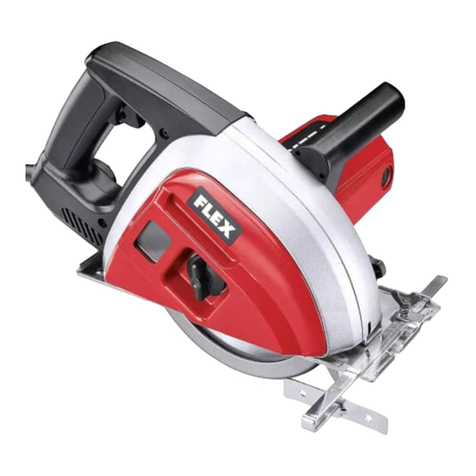
Flex
Flex CSM 4060 User manual
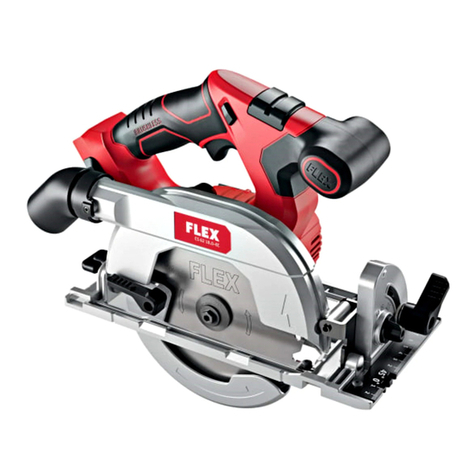
Flex
Flex CS 62 18.0-EC User manual

Flex
Flex CSM 4060 User manual

Flex
Flex CS 45 18.0-EC User manual
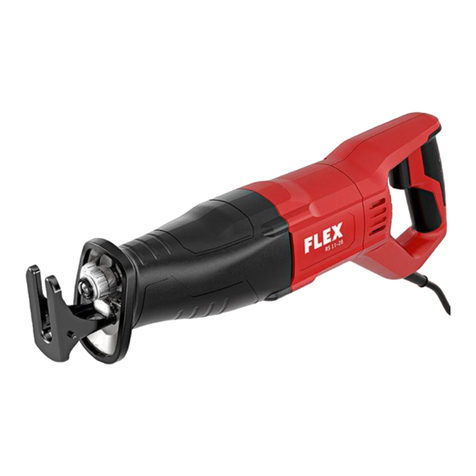
Flex
Flex RS 11-28 User manual

Flex
Flex WB 110-260 User manual
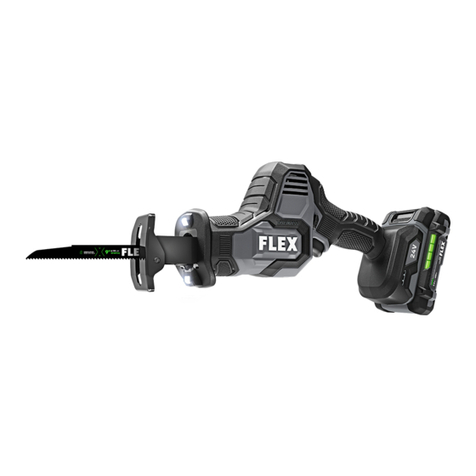
Flex
Flex FX2241 User manual
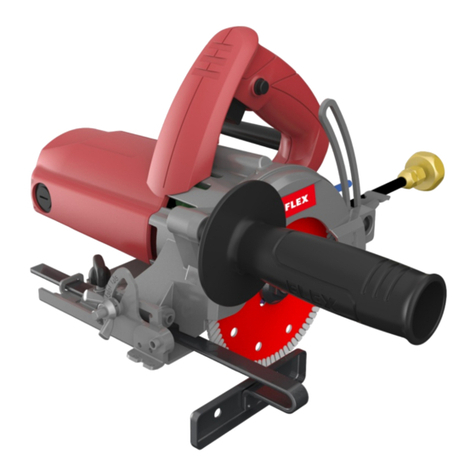
Flex
Flex CS 40 WET User manual

Flex
Flex CSE 55 T User manual
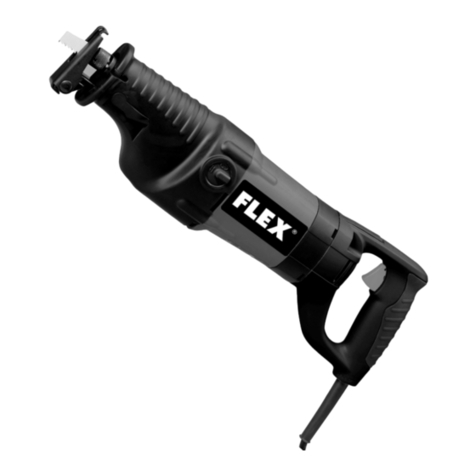
Flex
Flex SKE2902VV User manual
Popular Saw manuals by other brands
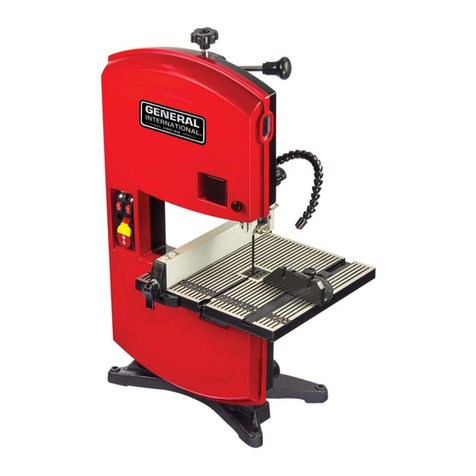
General International
General International BS5105 Setup and operation manual

Jet
Jet PB-150 Operating instructions and parts manual
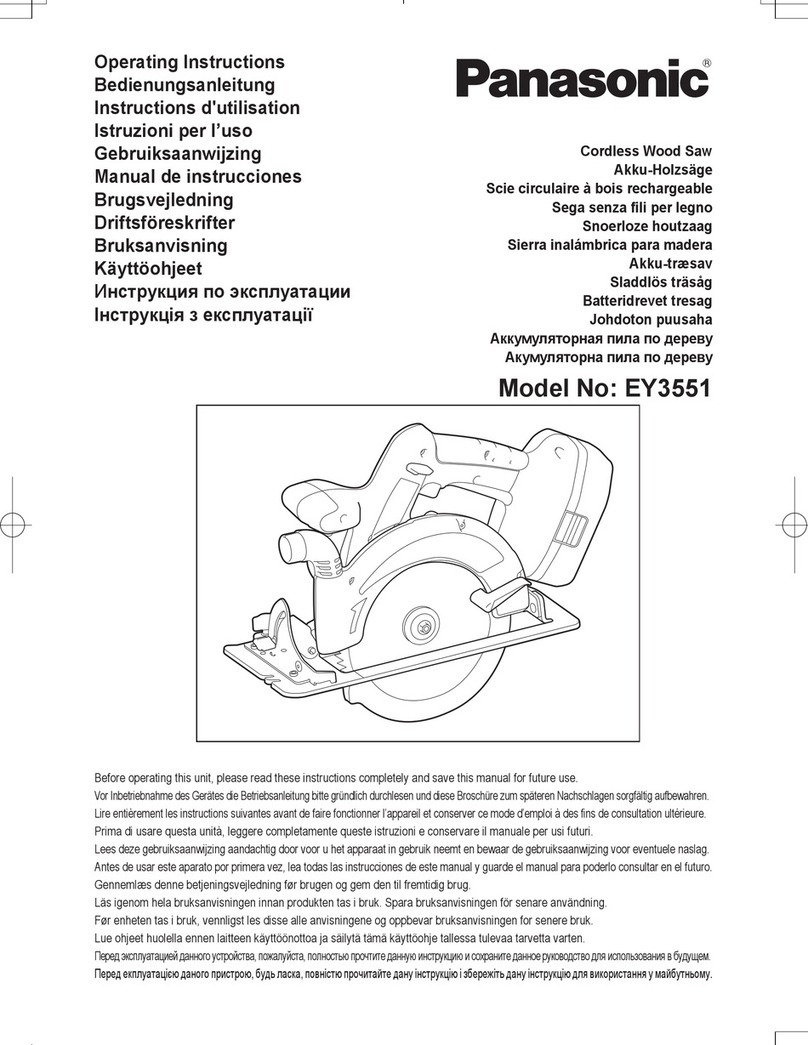
Panasonic
Panasonic EY3551 - 18V WOOD SAW operating instructions
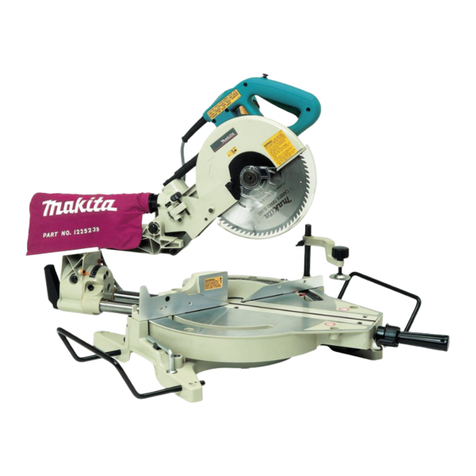
Makita
Makita LS1013 instruction manual
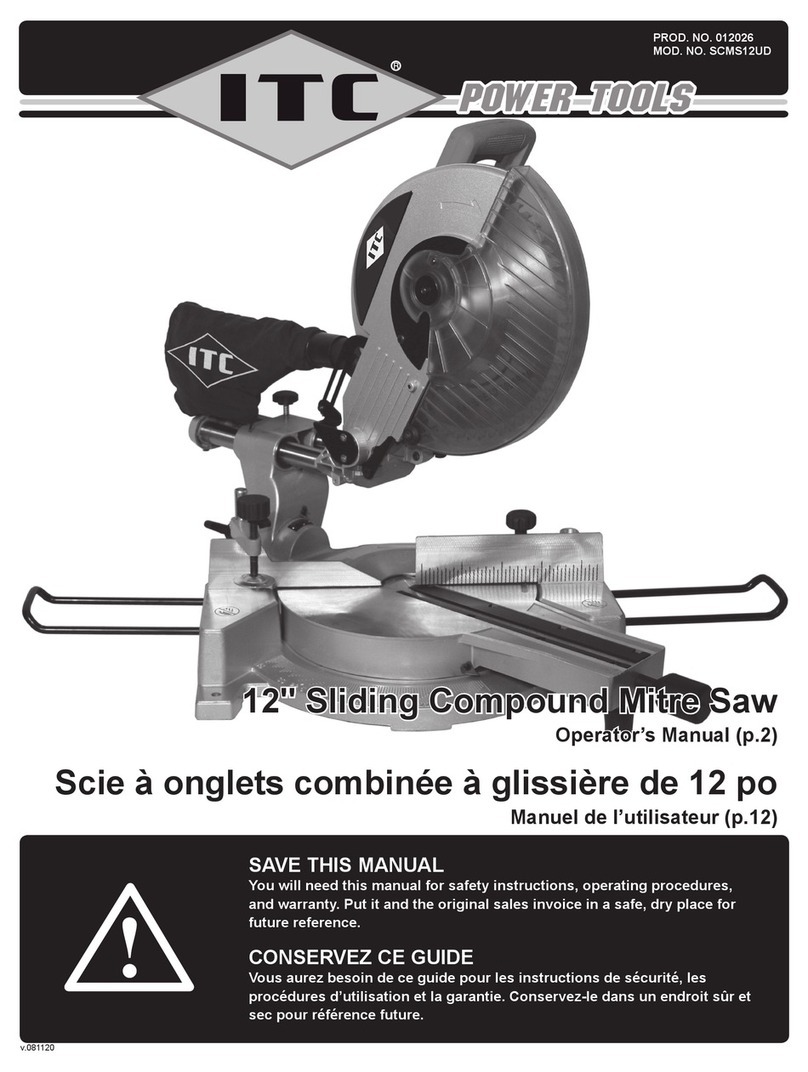
ITC
ITC SCMS12UD Operator's manual

King Canada
King Canada KMB-10 Service manual & parts list
